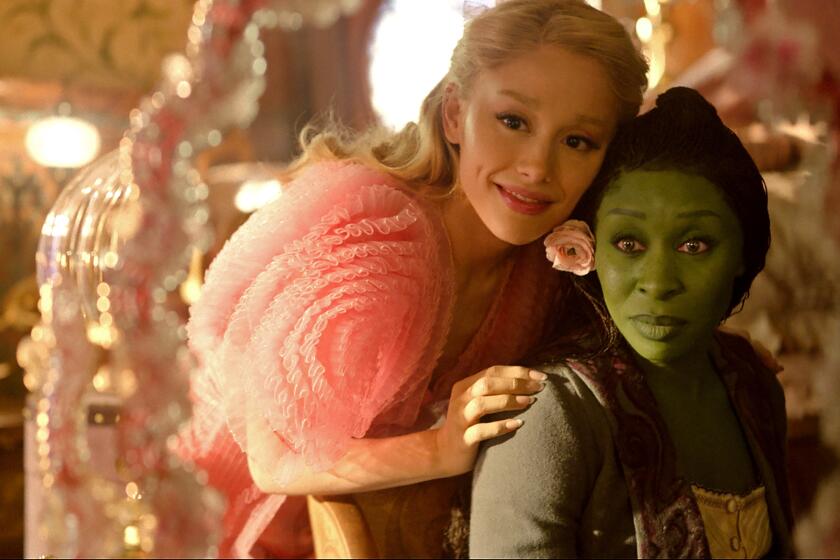At least dancers had a ‘Ball’
In celebrating its ninth anniversary Wednesday, the Carnival “Choreographer’s Ball” at the Key Club in West Hollywood offered a jampacked and up-to-the-minute survey of the achievements, priorities and limitations of dance in film, television, rock shows and other so-called commercial contexts.
As always, this late-night monthly showcase treated a crowd seated or standing on many levels of the club as a community -- the professional dance world. So the three-hour, 22-part evening contained constant announcements of upcoming events, pleas to aid a stricken colleague, acknowledgments of recent gains in working conditions and an affectionate tribute to director-choreographer Adam Shankman, winner of this event’s lifetime achievement award.
Best known perhaps for the recent “Hairspray” film, Shankman interacted happily with award presenter Kenny Ortega (the “High School Musical” television films). Together, they represented dance’s current Hollywood power center as masters of wildly successful projects that have upgraded the visibility of the art on screens everywhere.
“My first love and belief is dance,” Shankman said, and you could see that statement embodied in the video clips documenting his career. What’s more, the influence of his and Ortega’s recent triumphs could be found in a number of pieces by the program’s dance-makers, most performed to recorded music and all untitled. They featured happy young people bursting out of their normal routines -- in a schoolyard, on a street, at a Starbucks -- into joyous, rhythmic pop dancing.
Phlex’s bold and often fierce choreography for 16 dancers -- stronger in its use of the arms than in steps -- may have been the most exciting of these scenes. The actual moves in group works by Tony Gonzales, Matt Cady and Eddie Garcia proved equally splendid, but weak endings undercut their accomplishments.
Garcia tried for a shocking finish -- a slow-motion depiction of an in-school shooting -- but his staging and use of music left the result inconclusive. A few other choreographers emphasized dark visions -- Leslie Scott’s portrait of Hollywood exploitation, for example, which ended with the dancers holding large mirrors up to the audience.
The strangest of these downbeat essays turned out to be Robert Hoffman’s supposedly cautionary demonstration of how alcohol abuse ruins dancing. He accomplished this by having his crew perform a brief piece sober, repeat it after a few drinks and then, late in the evening, return so sloshed that two of the dancers fell off the stage. Please, Mr. H., don’t use dancers as lab rats -- they’re too valuable.
Working with guest choreographer Gustavo Vargas, Carnival executive producer-director Carey Ysais playfully combined Latin ballroom steps with an “I Love Lucy” plot line, while Alex DaSilva simply let the steps speak for themselves in an expert Latin adagio opposite Alien Ramirez. The most sensational duet, however, came from Realis: tiny, fearless Shenea Booth being effortlessly lifted, flipped and held on high by hunky Arthur Davis.
Among the most original entries were an unpredictable, dividing and imploding ensemble by Andre Fuentes and, best of all, an elegant, ominous octet by Blake McGrath and Bobby Newberry teeming with sharp small-scale moves that didn’t need the masks and makeup imposed on the cast.
Martial arts by the junior team from Sideswipe, jazz-dance choreography by the late Michael Peters (courtesy of Joseph Malone’s group) and pieces credited to Legacy, Tainted Angels, Michelle Elkin, Rob Schultz and Sonya Tayeh completed the program, for which Kimo Keoke served as artistic director.
The combined effect: hedonistic overkill galore. Along with unsatisfying endings, too many pieces suffered from a lack of any expressive statement other than “Watch this, watch me,” leaving much of the dancing emotionally vacant.
So much prowess, so little feeling.
--
More to Read
The biggest entertainment stories
Get our big stories about Hollywood, film, television, music, arts, culture and more right in your inbox as soon as they publish.
You may occasionally receive promotional content from the Los Angeles Times.










